An Age-by-Age Guide to Explaining the Death of a Pet to Children

From goldfish to guinea pigs to every pet in between (yes, including dogs and cats, of course), pets are part of the family.
The topic of pet loss in families is so common and it can be difficult for the whole family to grieve when a beloved family pet eventually passes. “Marley and Me” by John Grogan was a best-selling adult book because it so genuinely spoke to the difficulties of dealing with pet loss grief as a family.[1]
Even reality star Kim Kardashian addressed the topic of pet loss in an episode of Keeping Up With The Kardashians. When her daughter North's beloved hamster passed away and Kim struggled with ways to tell North the sad news, she vowed to never get her kids another pet.
(A common reaction of parents to watching their child cope with pet heartbreak, but chances are eventually you'll get a new pet one day, once everyone's emotional wounds are on the mend.)
Children often describe their pets as being part of the family, or the companion they turn to during difficult times, says Kristen Arquette, a licensed marriage and family therapist in Bellevue, WA.[2]
For many children, their first experience with grief is through the loss of a pet. While informing a sensitive child of a pet's death is especially challenging, learning to cope can help teach kids to process future losses.
Related: How Pets Can Impact Kids' Mental Health
Here are some ways to explain pet loss to your young, sensitive souls in a healthy way, so they'll eventually understand and find comfort.
Explaining the Death of a Pet to Kids 7 and Under
The way we discuss things like death and loss with kids looks very different depending on your child’s age.

For younger children and preschoolers, their emotional development and maturity level may not be fully developed enough for them to understand what has even happened after a pet has died.
Here’s how to carefully broach the topic of death to kids under 7.
1. Prepare Them
Speak with your child as soon as possible and choose a familiar, peaceful place and a quiet time to talk. Pets die for a variety of reasons -- old age, illness, or injuries.
"Talk about the possibilities of a terminally ill or older pet dying, and the associated feelings, before the loss occurs," advises Arquette. Reassure children that they can still enjoy the time they have with their pets.
2. Choose Words That Are Direct, Honest, and Calm
According to Arquette, when talking with your kids about what happened, use the words "death" and "dying" rather than phrases such as "went to sleep," "went away," "went to heaven” or “crossed the rainbow bridge.”
“Make sure your child understands that dying means that the pet's body has stopped working, and the pet will not come back. Subtleties and euphemisms can cause confusion and anxiety, and lead to misunderstandings and mistrust," says Arquette.
3. Don’t Ignore Questions They Ask
According to Arquette, it's okay to give the child additional information if they ask. "Questions are a signal that they want to talk about the loss, and are an opportunity to provide comfort. The level of detail provided should correlate to the child's questions."
4. Remember That Every Kid Will Process the News Differently
Note that a child's understanding and ability to cope with death is impacted by their age and developmental level. Most kids under six cannot grasp the permanence of death," explains Arquette.
Their behaviors may regress temporarily, or they may see themes of death in play, such as make believe that the pet is still alive or has just died. Young children may be confused or in denial and need to be told repeatedly that the pet's body stopped working and it died.
They may believe that they somehow caused the death, and need to be told that it was not their fault. They may also benefit from reminders that the pet died because it was sick, and that caregivers are healthy and will continue to care for the child.
5. Don't Lie
It may seem so easy to just blame the vet, but don't. "I've heard all sorts of stories, many blaming the doctors or saying the pet ran away," advises Judy Morgan, DVM, a New Jersey-based veterinarian.[3]
"Never make the veterinarian or doctor out to be bad, as this will scare children away from seeking help for a sick pet or person in the family. Saying the pet ran away leaves the child always looking for the pet, wondering why the pet did not love them enough to stay."
6. Use a Book To Explain Death
There are many great children’s books out there that explain the concept of death or loss of pets in a comforting, easy-to-understand way.
One book Dr. Morgan recommends is “Until We Meet Again” by Melissa Lyons.[4]
“This is an awesome book that we give to families when a pet dies, from any means. It is filled with wonderful prose and hand-drawn pictures of animals of all types," says Dr. Morgan.
Explaining the Death of a Pet to Kids Over 8

As kids grow older they may be better at understanding loss, but still need some help dealing with their emotions and going through the steps of the grieving process. Here are some ways you can help older kids process the death of a family pet.
1. Explain the Role of Euthanasia
If your pet had to be euthanized, your child may have some questions about what “being put down” means and if it hurt the animal in any way.
Older children, especially, are often curious about euthanasia or other details of death. "Explain that the vet will give the pet a shot to put them to sleep and stop their heart from beating," says Arquette.
Before euthanasia, explain that the pet wasn't going to get better, and that the family chose a kind way to help the pet die without pain.
2. Talk With the Vet
"Please be honest with your children, tell them the truth," stresses Dr. Morgan. "Ask if they want to be present when euthanasia is performed and if they want to see or touch the body.
Closure is very important for children. Teenagers sometimes struggle the most and it is important to include them in the process."
3. Remind Teens It’s OK to Cry
According to Middle Earth NJ, a non-profit agency and online resource guide dedicated to empowering today's youth, teens need their parents to validate their feelings and understand how much they miss their pets.[5]
"It's important to let your teen know that grief is an appropriate response and everyone expresses it in different ways (crying, numbness, apathy, staying busy, etc.), all of which are normal."
Dealing with the Death of a Family Pet At Any Age
Even though a pet’s life is shorter than a person’s, the impact a beloved pet makes on the whole family lasts a lifetime. No matter what age, here is some advice on how all members of the family can ease their sadness and healthily come to terms with the loss of that special loved one.

1. Remind Kids That You’re Sad Too
Validate the child's emotions, and if you're upset too, it's okay to let your child see your feelings so they know they aren't alone in their grief, explains Arquette.
Grief ebbs and flows, and it is natural to have all kinds of feelings after someone as special as a pet dies. She recommends talking about what the pet meant to you and how much you miss it, as well as special things the family can do to remember it.
2. Engage in a Goodbye Ritual
"Choosing a good-bye ritual can also be helpful to honor the role the pet had in the family, such as making a scrapbook, holding a memorial service, or scattering the pet's ashes," says Arquette.
"Children can be encouraged to share their feelings by talking, writing, or drawing about the fun times they had together and what their pet meant to them. " Allow your child to contribute to the memorial if they want to, " advises Arquette.
Some ideas to say goodbye to a pet for kids could be by decorating the grave marker, finding a burial place, or choosing an item such as the pet's favorite toy to bury with it.
3. Share Your Own Animal Story
Says Arquette: "Some children may benefit from reading books about families who have lost pets, or from hearing a parent talk about the special pets they had when they were young, and how they coped with the loss of those pets and eventually felt better."
Losing Pets: How To Explain Death to a Child
Sadly, pets don't live forever. If you have an animal family member, you might be wondering how to tell your child their pet died—it's inevitable and heartbreaking, but walking your child through the process with compassion and understanding is key. Depending on your child's age, there are different methods of helping them come to terms with the loss, and help them heal.
For more good children’s books about dealing with loss and death, we recommend this list of 12 Children’s Books That Help Explain Tragedies and Death to Kids.

